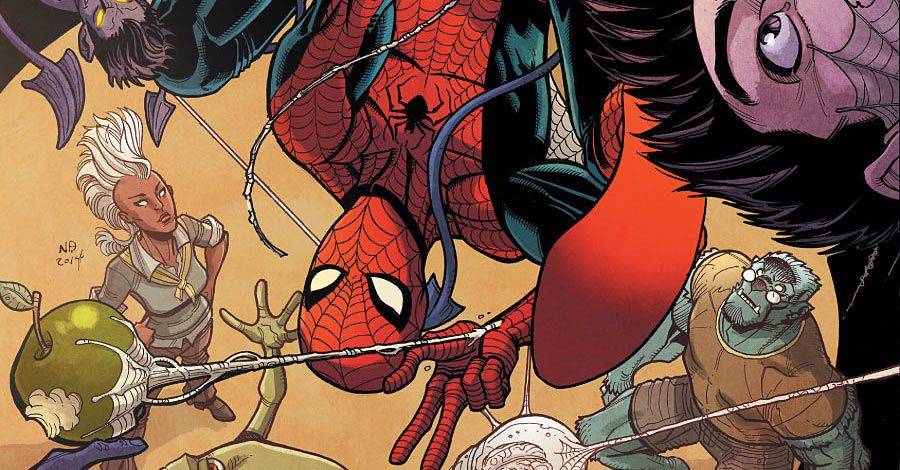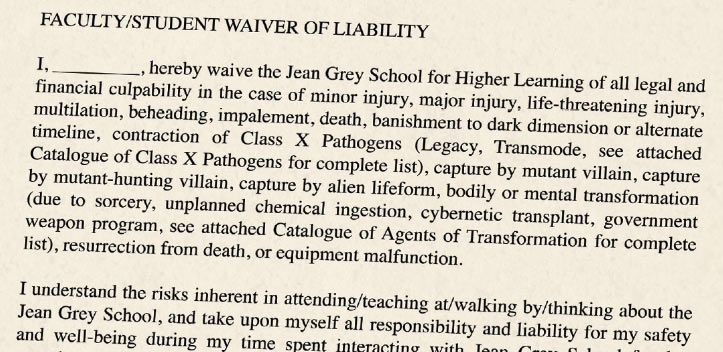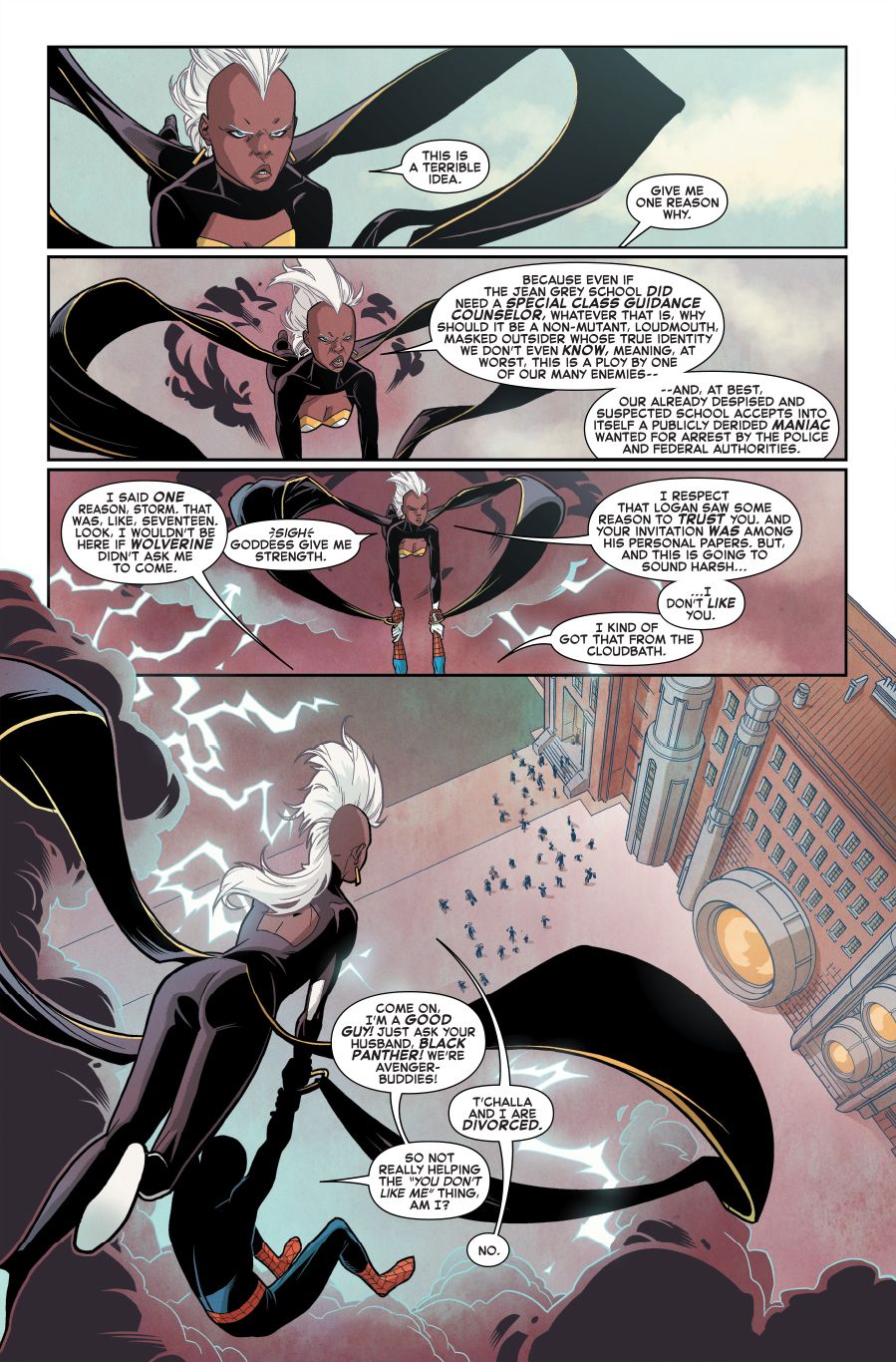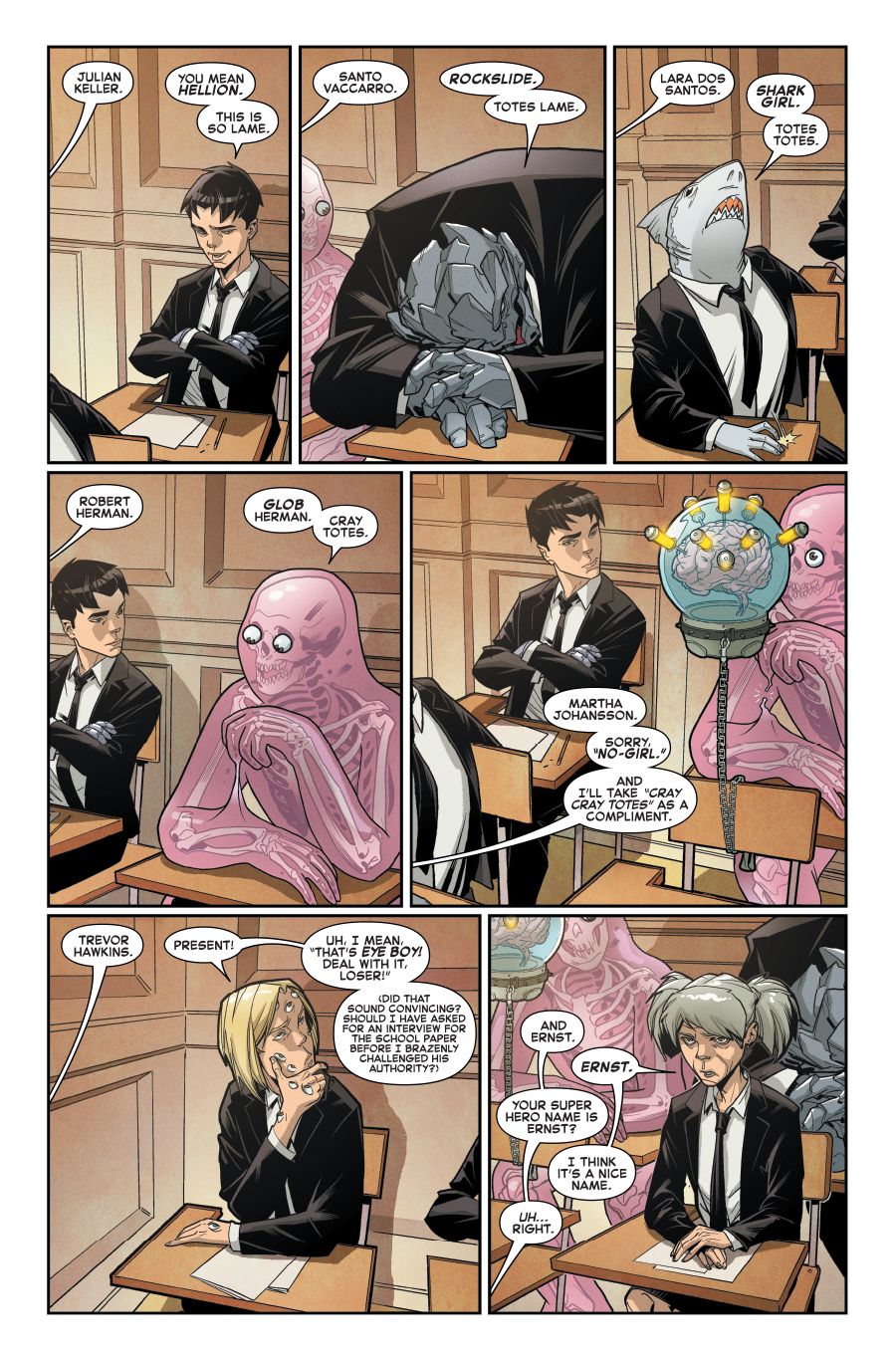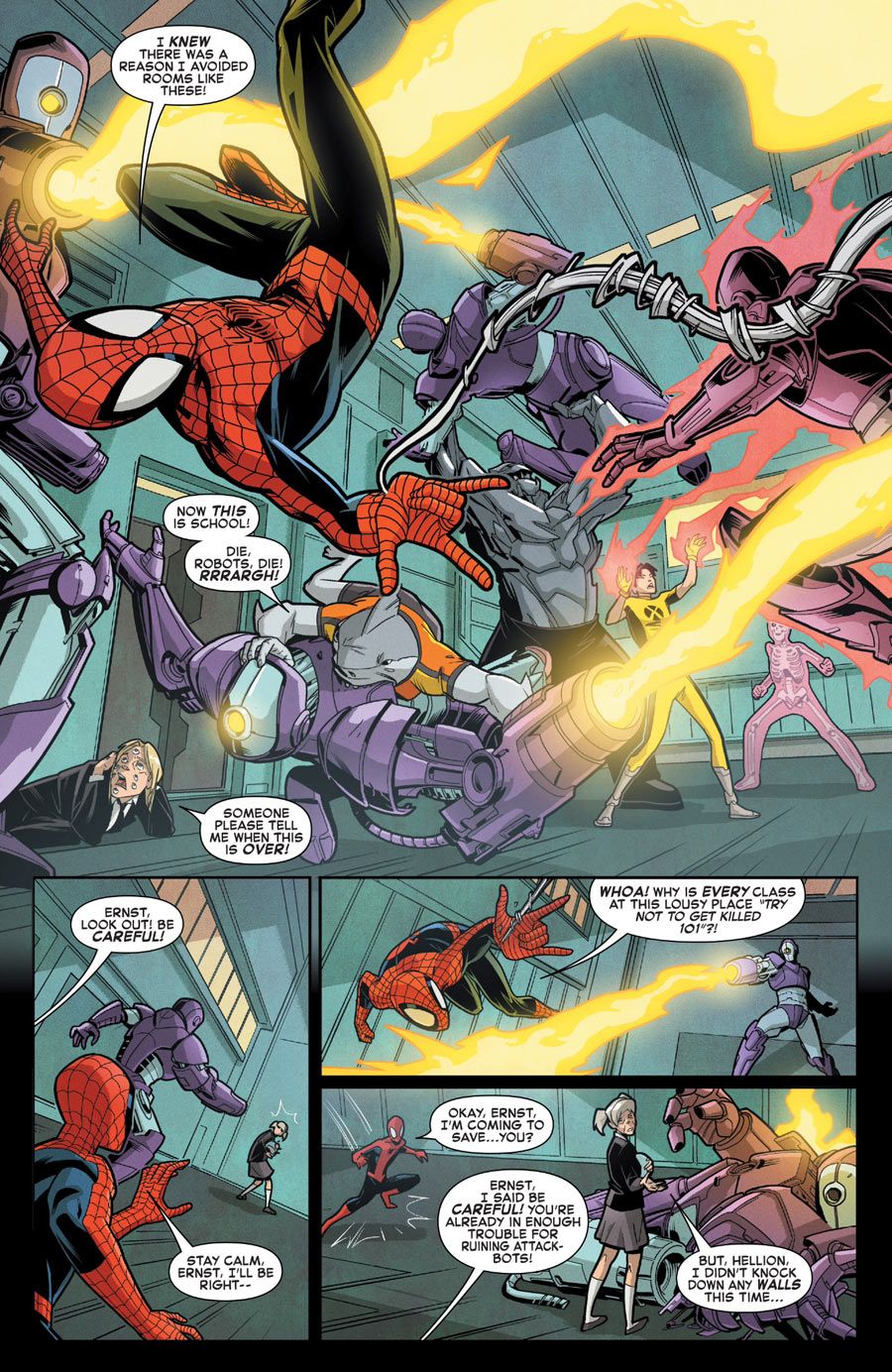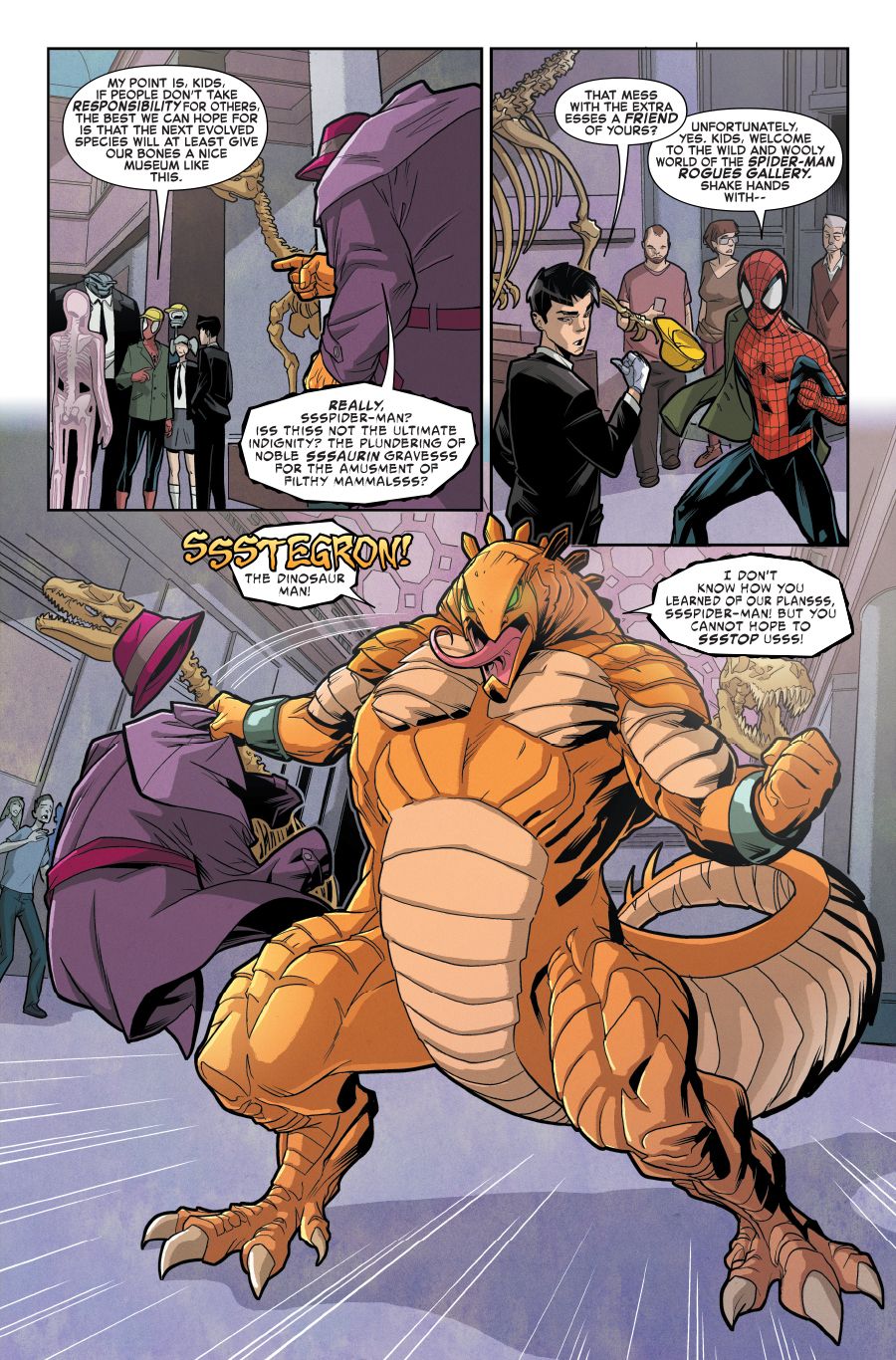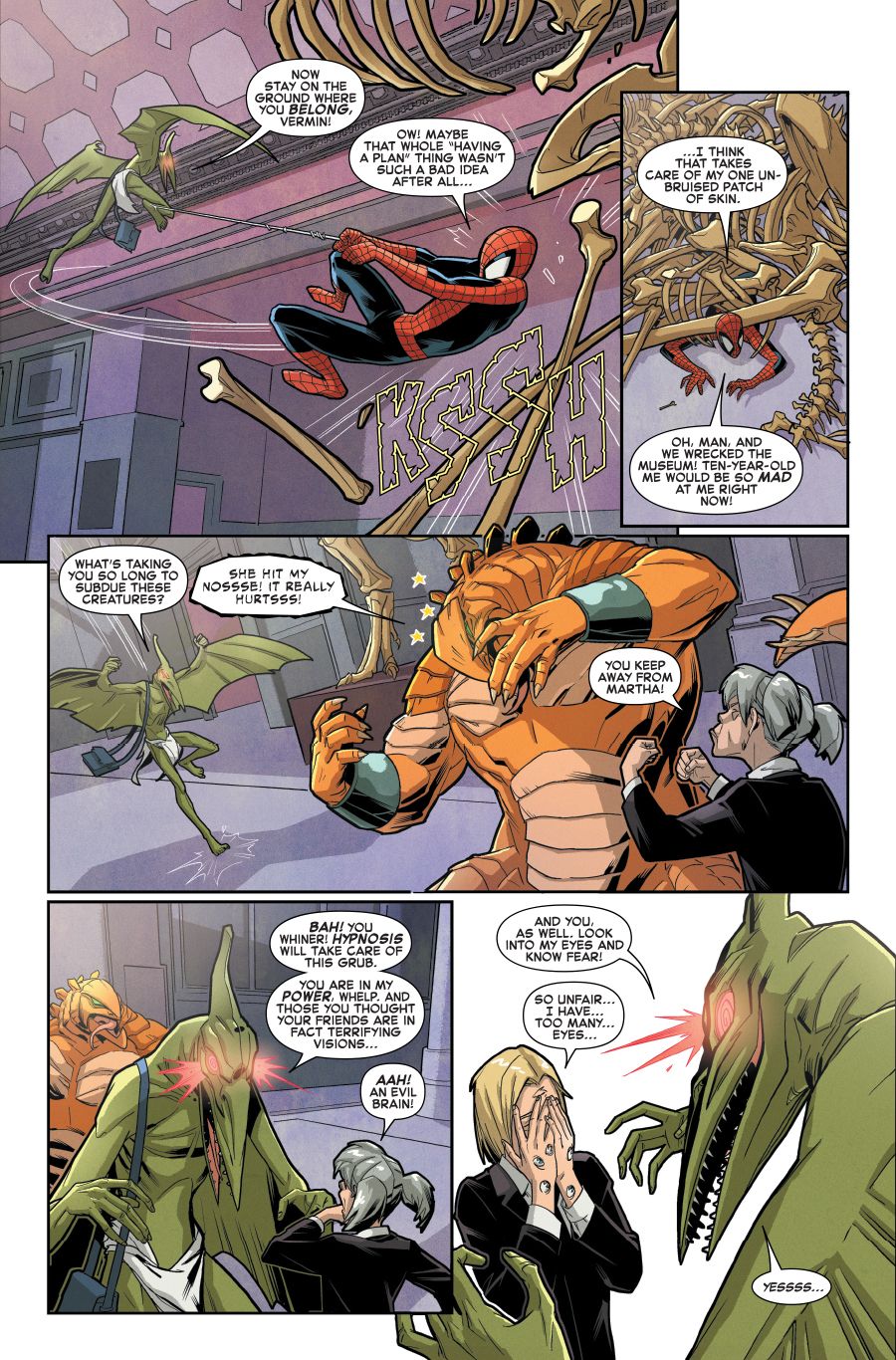After three years and over fifty issues with Wolverine at the helm, the Marvel Comics series dedicated to chronicling the exploits of the staff and students at the Jean Grey School has a new superhero in the title and behind the teacher's desk. "Wolverine and the X-Men" has become "Spider-Man and the X-Men," and nothing will ever be the same now that they have Marvel's wise-cracking, science-loving, wall-crawling do-gooder on the school's payroll. In the debut issue -- in stores today -- Peter Parker joins the faculty as its Special Class Guidance Counselor, determined to give some of the more trouble-prone students a lesson in ethics.
X-POSITION: Elliott Kalan Swings Into "Spider-Man and the X-Men"
With the series hitting fans' hands today, CBR News caught up with series writer -- and "Daily Show" writer -- Elliott Kalan, whose previous Marvel Comics work includes "Wolverine Annual" #1 and stories in "Superior Foes of Spider-Man" and "Marvel: Now What?!," to take a page-by-page behind-the-scenes look at his and artist Marco Failla's "Spider-Man and the X-Men" #1, so grab your copy of the issue and follow along below.
CBR News: The waiver on the recap page is jam-packed with jokes and references as well as a lot of legalese. Did you also write the recap page, and if so, how research heavy was it?
Thanks for reading through all that little text! It was [editor] Katie Kubert's idea to throw some extra funny stuff at the top, but I wrote the jokes on that page -- the waiver and the superlatives in the yearbook. Sadly, I think the only research I had to do for it was to see if the X-Men already have an established lawyer, which it turns out they do. Otherwise, it was a lot of me just going back and remembering all the stuff I've read happen in X-Men comics over the last couple decades.
Page 1: Storm is the first X-Man we see interacting with Spider-Man. What inspired you to create their humorously antagonistic dynamic?
There are two things I don't love in superhero comics: When all the superheroes fight each other all the time, and when all the superheroes are best buds who love each other all the time. I like to have a little bit of interpersonal conflict. That's the general take.
Specifically with Storm and Spidey, though, I put their two personalities together and realized that even though they aren't enemies, they don't really seem like they'd choose to spend time with each other. Storm doesn't have the strongest sense of humor, and Spider-Man can be annoying. On top of that is Wolverine asking Spider-Man to join the school without telling anybody -- a real affront to Storm's position, there. It's like Storm's boyfriend invited his friend that Storm doesn't really get along with on their vacation without telling her. It felt more real and funnier to me than everybody instantly getting along. Sometimes you have to win someone over, and part of Spider-Man's challenge will be winning Storm over.
Page 2: We quickly get to see classic X-Villain Z-Lister Unus the Untouchable. What led you to dust him off and put him to use again?
First off, Unus the Untouchable is way better than Z-List, and ever since I found out he was back from the dead, I've wanted to use him in something. I actually had much bigger plans for him, with Spider-Man getting through to him with words and proving Unus is touchable when it comes to his emotions.. -- but there are just too many stories to tell in this world and not enough time. I like him because his power is really only a threat if you're running to or throwing something at him.
Unus is a great name. His costume looks like it has a menorah on it, and he's an X-Men villain that's not completely out of Spider-Man's power class the way someone like Apocalypse or Magneto is. Frankly, just writing this now is making me wish I'd done more with him.
Page 3: In just two panels, Beast and Spider-Man quickly establish a competitive dynamic that seems ripe with potential. Is this particular character pairing one that excited you when you took on the book?
Yes, very much so. The three things that really excited me about this project was 1) writing Spider-Man, 2) getting inside the heads of some of the newer X-characters, and 3) seeing what happens when Spider-Man pushes himself into the X-Men's world. A big part of that is the implicit challenge to the school's science champ when another scientist who's also a fun, bouncy guy comes in. Of course, Spider-Man and Beast have long been friends -- a story that made a big impression on me in my youth was the one where Spidey consults Beast on whether it's safe for a man with radioactive blood to have children. But that friendship is a lot easier when Beast and Spider-Man aren't on their home turf. Now, Spider-Man's invading Beast's space, and Beast is not cool with that. It comes to a head in later issues.
Page 4: The issue is filled with callbacks to Marvel continuity, like the Frog-Man reference on this page. Are you pulling these out of your head or is there a lot of research involved?
Usually, it's me half-remembering something and then researching it further to make sure I'm not completely wrong. I've been a Marvel fan for over 20 years, and I used to do a lot of back issue catching up (and frankly, do even more of that now that Marvel Unlimited exists). And for some reason that stuff sticks in my mind when, say, remembering to write my grandmother a thank you note does not.
Page 5: You have Spider-Man vent a lot of his frustrations with being a newcomer to the X-Men. As a new writer in the X-Men line, how much do you relate to Spider-Man on this page?
More than I should probably admit. I'm not new to the X-Men world as a reader -- I've been a fan of their books almost as long as I've been reading Spider-Man's -- but as a writer it can be very hard to keep track of who's doing what and where and what's happened to this character and that character and another character. And my knowledge of what was going on with the X-Men in the '80s and '90s seems particularly inapplicable at the moment. I imagine Spider-Man being like a reader who's jumping into the X-Universe after years away and feeling, "Wait, who's this person? Where's this other guy? Hold on, those two are dating now?"
Page 6: The selection of students in this book cover a wide range, from Morrison-era additions, like Ernst and No-Girl, to very new characters like Shark Girl and Eye Boy. How did you choose your cast?
Partly off of which characters looked neatest, partly off of characters I think are interesting that haven't been used too much, but mostly from who would have an interesting personality to play off of Spider-Man or a possible motive to be the mole working for the X-Men's enemies. To an old man like me, even the Morrison-era characters feel very "new," much the same way Psylocke and Longshot felt to the readers who came before me, and Storm and Colossus felt to the readers who came before them, and so forth. So a lot of my choice was just: which characters seem cool enough that I want to spend time getting to know them more? Who have I been curious about? Some of the choices were very thought out and others were just, "That guy would look cool in a group team shot! Now I just need to figure out who they are and what they do!"
Page 7: "Danger Room = Uh-Uh" is such a great visual gag. Is a lot of the book's visual humor in the script, or is that done in collaboration with series artist Marco Failla?
Thanks! It's a mix, but a lot of it (like that line) comes from the script.
Page 8: You use the Bamfs a lot, which were added to the cast by Jason Aaron in "Wolverine and the X-Men." How present are those previous Jean Grey School-set series in your mind while breaking stories for "Spider-Man and the X-Men"?
They are both always present and big shoes for me to live up to, and also something I force myself to forget from time to time so that I'm not too intimidated to just write the story. I want the reader to feel like this is the same world that was created in "Wolverine and the X-Men", which for me is the standard for a great modern X-Men title, so I'm trying to keep the setting mostly recognizable. That being said, a number of upcoming issues take place almost entirely away from the school. If I was psychoanalyzing myself, I'd say that it's an anxiety of influence thing, and I'm dealing with Aaron's shadow by running from it whenever I can.
Page 9: How did you make it nine pages before doing a Danger Room sequence? That's definitely one of the big toys in the X-Men's toybox.
It is, but there's something about the limitless quality of what can happen in the Danger Room that, paradoxically, freezes me up as a writer. I work best when I have or set certain limits for myself. "This book is about this character and this is the villain and it's in this setting. Okay, great, now I have some boundaries to work within and I can figure out how everything connects."
And I'll just say it: I think the Danger Room is kind of boring. It's a good way to introduce how characters' powers work and let them interact with each other, but it also means everybody's just hanging around the school fighting robots and holograms when they could be out there doing things in the real world. In a way, Spidey's issue with the X-Men's philosophy is like my issue with the Danger Room -- quit playing video games in your basement, X-Men, go out and run around in the sunshine!
Page 10: How did you decide to slide in an ethics lesson in the midst of a Danger Room training sequence? Was it hard to work in the words with the action shots?
This may sound weird, but Spider-Man is one of my two ethical/moral polestars -- along with Abraham Lincoln. I truly am inspired by the character, and a lot of that has to do with how, over 50 years, he has openly wrestled with the ethical demands of a heroic life. If I was going to write Spider-Man, I wanted to write him as an ethical figure.
At the same time, the X-Men have a very particular and valid set of ethics -- Spidey's is about selflessness, and the X-Men's are based on species preservation. Who's to say which is right? That philosophical battle is, if anything, more exciting to me than just watching them fight a bunch of robots. Luckily, a signature Marvel thing is characters stating their moral POVs and motivations as they fight, so an ethical discussion during a robot battle works just fine.
So it wasn't hard for me to fit the words into the scene, but it may have been hard for Marco to fit space for all those words in the panels!
Page 11: This is where Spider-Man first suspects that Rockslide may be the mole within the student body. How did you come up with Spider-Man's ulterior motive for taking the guidance counselor job?
I wish I had an interesting story behind that, but it was literally just, "So what reason might Wolverine have for asking Spider-Man to teach at the school? There's a mole! Okay!" Early on we decided not to have a flashback or video or anything of Wolverine -- I think it strengthens the idea of his absence to completely avoid showing him. But I do regret not getting to write a scene between them. The way their relationship had developed over the past few years is a lovely thing.
Page 12: During the field trip, you really get to have fun with Ernst and No-Girl's dynamic -- specifically the "sabotage" joke. Do you like writing jokes for a character like No-Girl, who is functionally silent?
At first, I was really frustrated that I had a character who can't directly talk -- though I found a way to get around that later. On the bright side, though, for a chronic over-writer like me, it's fewer word balloons to clutter up the panels! I'm still learning how to make the best use comedically of how we can see people react to her, but can't see her actual words.
Page 13: Honestly, how long have you been dreaming about putting Stegron front and center in a Marvel comic?
A long, long time. Stegron's one of those characters I inexplicably love when nobody else does (like D-Man or The Prowler), because he should be cool -- he's a dinosaur-man! -- but he usually comes off as a trying-too-hard knock-off of The Lizard. But I've always believed there was a lot of potential in him for both action and emotion. And again, he's a dinosaur-man.
Page 14: This page mixes a lot of jokes (Spidey's comment about photos) with action and dramatic suspense (No-Girl's failed attempt to possess Stegron). Do you have a joke-to-action ratio that you try to hit or have found to be ideal?
Not really, but I should. I like to have at least two action scenes per issue and as many jokes as possible throughout -- if I could fit a joke in every panel, I would. On the other hand, too many gags turns this into a "What The--?!" story. So it's a balance that I try to achieve by playing it by ear and seeing how the moment of a scene feels. Sometimes it just doesn't make sense for a character to tell a joke. With Stegron, I wanted him to be funny, but also to remind people he's a real threat. If I'm doing it right, then people are laughing and want to see how things turn out. There's probably a mathematical formula for that, but I haven't figured it out yet.
Page 15: With fight sequences like the one in the museum, how much of that is broken down panel-by-panel in the script, and how much does Marco choreograph?
I break it down by action, but Marco decides the angles, page design, and so forth. I should probably rely on him more, but it's hard for me to write the dialogue and story if I don't know exactly what the character is doing in the moment. I'm a failure when it comes to the old Marvel Method!
Page 16: Sauron's appearance in this issue really brought a smile to my face, as he's such a delightfully over-the-top villain. Is he as much fun to write as he is to read?
Even more so. I love writing an over-the-top but threatening villain who is convinced he's better and smarter than everyone around him. Sauron is genuinely dangerous but come on, he's a world-conquering Pteranodon-man. Why not play that to the hilt? It's almost as good as the time I got to write a 1970s Dr. Doom for "Iron Man: Iron Age." That was the best ever.
Page 17: Explaining a joke is a surefire way to kill it, but the Eye Boy vs. Sauron bit on this page is too good not to dissect. How did that showdown -- between a hypnotic villain and a boy covered in eyes -- first come to you? Do you run through the book's cast and figure out their dynamic, or do these gags arrive naturally?
In that case, it was just a matter of realizing that Sauron hypnotizes people and Eye Boy can never completely cover his own eyes. It was a happy accident of thinking about the characters in the scene and putting them together. But that's basically joke-writing! "Hey, this thing and this thing go together! Ha!"
Pages 18-19. After Sauron hypnotizes Spider-Man, he wakes up in what appears to be the Savage Land, and Shark Girl is exposed as a mole. But, is she the mole, or is that mystery going to last through the arc?
It certainly appears that she's the mole! Still, kind of weird to reveal that right away, right? And am I really going to make Sauron and Stegron the reason Wolverine asked Spider-Man to join the school? Probably not. So the odds against Shark Girl being the original mole are fairly high, even if she has just joined the Sauron-Stegron team. That still leaves a lot of possible suspects!
Page 20: The Staten Island as New Savage Land reveal is great, as it ups the stakes and acts as a great punch line for the issue. Were you going for a cliffhanger that would get both a gasp and a laugh?
The goal is to get both of those reactions as often as I can. Although to go for the gasp I had to cut a couple Staten Island jokes I was sad to lose. I'm a sucker for cliffhanger reveals, so if I can do it I'm going to end every issue on a cliffhanger of some sort. What kind of cliffhangers? Pick up the book to find out!
That's how you end an interview on a cliffhanger.
"Spider-Man and the X-Men" #2 arrives in stores in January 2015.

